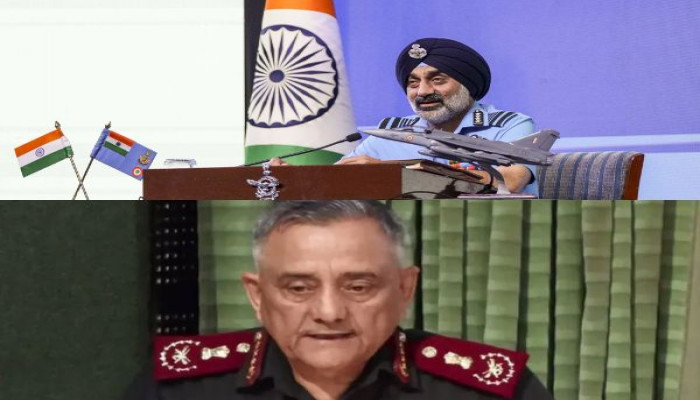'4 to 5 fighter aircraft, most likely F-16 destroyed,' IAF Chief AP Singh on Operation Sindoor
- In Reports
- 06:38 PM, Oct 03, 2025
- Myind Staff
Indian Air Force Chief Air Chief Marshal Amar Preet Singh on Friday shared details of the damage caused to Pakistan during Operation Sindoor, giving a clear picture of the targets hit and the losses that followed.
Operation Sindoor was launched after the Pahalgam terror attack and involved precise strikes on terror bases in Pakistan and PoK in May this year. The Indian Armed Forces not only stopped Pakistan’s attempts to escalate but also carried out coordinated attacks on several of its airbases.
At a press conference in Delhi, Singh was asked about Pakistan’s losses. He stated that India had targeted many of their airfields and installations. “As far as Pakistan's losses are concerned...we have struck a large number of their airfields and we struck a large number of installations...Because of these strikes, radars at least four locations, command and control centres at two sites, runways of course damaged at two locations, then three of their hangars in three different stations have been damaged.”
He went on to describe the effect on Pakistan’s aircraft and defence systems.
“We have signs of one C-130 class of aircraft...and at least 4 to 5 fighter aircraft, most likely F-16, because that place happened to be F-16 with whatever was under maintenance at that time. Along with that, one SAM system has been destroyed...We have clear evidence of one long-range strike, which I talked about more than 300 km, which happened to be either an AEW&C or a significant aircraft, along with that, five high-tech fighters between F-16 and JF-17 class, this is what our system tells us,” the IAF Chief said.
The F-16 is a fighter jet made in the United States, while the JF-17 is developed in China.
Singh also highlighted the importance of India’s new long-range surface-to-air missiles and how they gave the Air Force an advantage deep inside enemy territory.
He said, “Our long-range SAMs that we had procured recently and operationalised...We could look deep inside their territory. We could make sure that they were not able to operate even within their territory up to a certain distance. It will go down in history that longest kill that we achieved of more than 300 kilometres by that. And it seriously curtailed their activities.”
Calling Operation Sindoor a historic achievement, Singh stressed that India went into the conflict with a clear plan and ended it without delay. He said, “A clear directive, clear mandate was given to the Indian Armed Forces... It stands as a lesson which will go down in history that this is one war that was started with a very clear objective, and it was terminated in a quick time without just prolonging it.”
He added, “We are seeing what is happening in the world, the two wars that are going on, there's no talk about termination. But we could make them reach a stage where they ask for a ceasefire, ask for termination of hostilities. And also, we took a call as a nation to terminate those hostilities because our own objectives are met. I think this is something that the world needs to learn from us.”







Comments